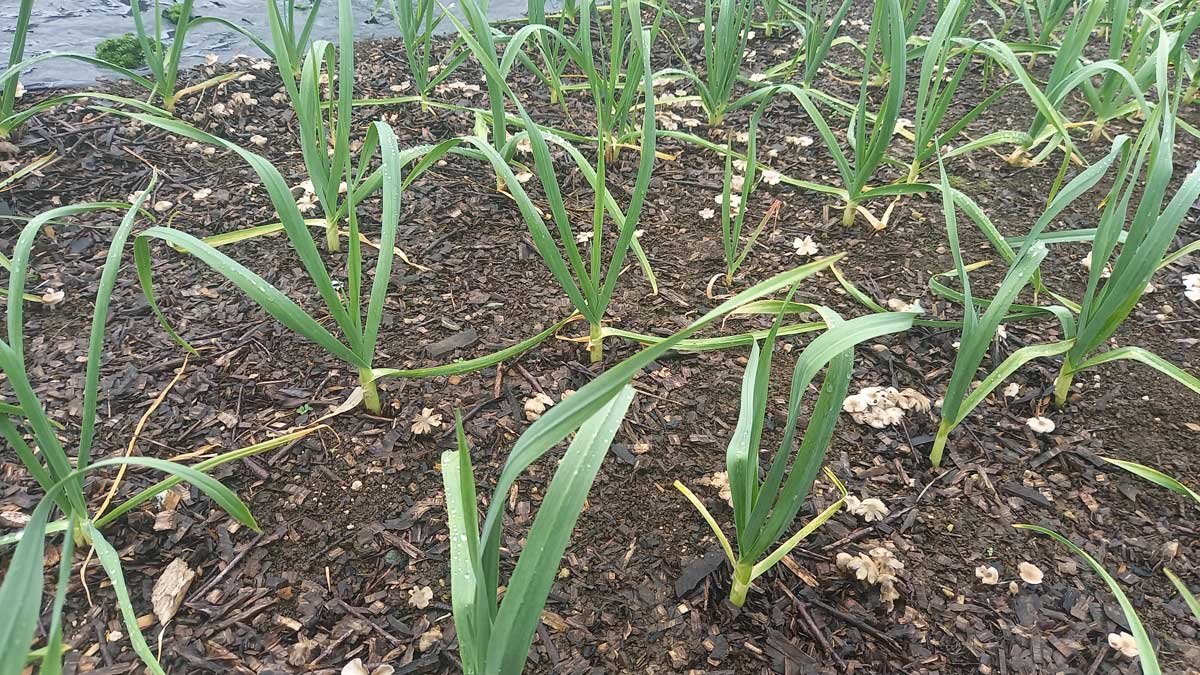3 months ago I somewhat unwillingly planted a bed and a half of garlic in the garden.
Last year had been a a shocker garlic season. It really left me at the end of my rope after becoming infected with rust.
But I’ve spent years collecting hard-to-find varieties of garlic. Planting this season was entirely about keeping my lines going. It had absolutely nothing to do with actually wanting to grow garlic in 2022.
Garlic takes six months to grow. This year, I’m growing according to the old adage that you should plant and harvest on the Solstices (shortest and longest days).
We’re now just past the Equinox (when day and night are the same length), so we’re half-way through the season. I thought it was time for an update.
A slow start
Germination rates were low this year. They’re usually somewhere between 98% and 100%. This year it averages to roughly 89%.
The White Rocombole in particular did poorly with only a 60% germination rate. It’s usually quite prolific though, so hopefully what did survive will pull through for me.
The Takahue (often a top performer) and Russian Red are at 90%, while the Spanish Red is at 95%. Both the Ajo Roja and Purple Rocombole (which wasn’t my seed, it came from Setha’s Seeds) had 100% germination.
I have this theory that the Ajo Roja performs slightly better against rust than my other varieties. It ‘holds out’ a bit longer and had the most consistent bulbs last year. It certainly did best with germination this time round.
Anyway, once they did get going, they struggled a bit with slugs. I might have lost a couple to slug attacks, so may need to lay down baits for young plants in future years.
The fun guys
This bed happened to hold a really large compost pile last year. Then last summer we applied a layer of woodchip from the Taiwan cherry that grow wild and unwanted in our bush.
When I went out to take photos for this blog, I was astonished to find the fungal networks – I assume from both these actions – are holding strong. The upper half of the bed was covered in inkcap mushrooms.

I’d like to take this as a good sign. Underground, there is a network of fungi that is clearly thriving in at least half of the bed. Strong mycelial networks will be working in symbiosis with the garlic plants to access nutrients and water.
I’m hoping it also makes them stronger against the “less fun guys” (aka, rust).
Apple cider vinegar experiment
I have been spraying the garlic regularly (near weekly, weather-depending) with apple cider vinegar. I’ve actually been spraying all the alliums in my garden, and many of my fruit trees too.
I figure it’s not going to hurt, and maybe it’ll help protect the plants against fungal infections like rust, black spot, and brown rot.
Per some lady on Facebook who made a very compelling post about it, I’m using a ratio of 1c (cheap) apple cider vinegar to 5l of water. Sometimes I add 1/4c of liquid organic fertiliser as a foliar spray too. I spray the garlic, chives, multiplying spring onions, leeks, and shallots.
Then I take it over to the feijoas, the grapes, the passionfruit, the berries, the strawberries, the citrus, then down to the orchard to do the apples and the stonefruit – anywhere I’m a bit afraid of something fungal ruining the fun. I usually keep going until I run out of spray in the tank.
So… is it rusty?
No! So far (touch wood), the only yellowing is stuff I expect – wind damage, slug damage, and a yellow stripe that some of the red-skins have always had on the lower leaf.

I’ve had to give the bed a very quick weed a couple of times now. Thankfully this one is light on the weeds. While I was down there I gave everything a pretty close inspection. So far, I’m cautiously happy. This crop looks much better than last year’s did.
So far, we are good. The next three months usually dry off so rain should be less of a problem, but now I’m hoping to avoid excess humidity.
In the next month or two, most of them will send out scapes. I’ve been asked to supply them in the past, but given last year’s crop was so rusty, they weren’t in any kind of condition to sell. But maybe they will be this year. Let me know if that’s something you might be interested in.
I’m going to continue to spray my apple cider vinegar for the rest of the season. And I’m considering where I might plant a larger patch next year. So maybe hope isn’t lost after all.


